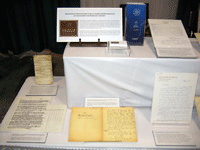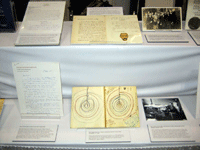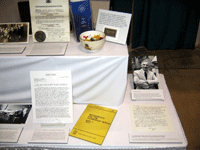Archives of American Mathematics Exhibit
Joint Mathematics Meetings,
San Antonio, January 2006
 |
 |
 |
| (Click on images to enlarge.) | ||
Notes from Ernst Hellinger's lecture on difference equations from the Frankfurt Mathematics Seminar, 1922-1923
Max Dehn (1878-1952) and Ernst Hellinger (1883-1950) both taught at Frankfurt University in the 1920s and 1930s until the rise of the Nazi party forced them to separately immigrate to the United States. From the Max Dehn Papers.
C. L. Siegel article with caricature for 1928 Festschrift in honor of Arthur M. Schoenflies, 6 November 1927
C. L. Siegel's article, "Ueber Riemann's arithmetischer Nachlass" ("On Riemann's arithmetical Nachlass"), was part of a tribute to Arthur Schoenflies, whom Siegel had replaced as professor of mathematics at Frankfurt University six years earlier. His colleague Max Dehn, a former assistant of David Hilbert, organized the compilation of the manuscript. From the Max Dehn Papers.
Walter Feit, 1988
Walter Feit (1930-2004) contributed to algebra, geometry, topology, number theory, logic, and finite group theory. He began his career in mathematics in 1953, joining the mathematics faculty at Cornell. In 1964, Feit made the move to Yale, where he remained for forty years until his retirement in 2003. From the Walter Feit Papers.
J. G. Thompson to Walter Feit, early correspondence regarding their cooperative paper, "Solvability of Groups of Odd Order," ca. 1960
The 254-page paper was published in 1963 and is widely regarded as the most influential paper ever written on finite group theory. From the Walter Feit Papers.
Hans Rademacher to Emil Grosswald, 9 April 1965
Emil Grosswald (1912-1989) received a master's degree from the University of Bucharest (1933) and continued his studies in Paris and Montpelier. He arrived in the United States in 1946 and received his Ph.D. from the University of Pennsylvania (1950). In 1952 he joined the Department of Mathematics at the University of Pennsylvania. Grosswald was an analyst, specializing in analytic number theory. His association with Hans Rademacher, also on the faculty, led to Grosswald's editing of Rademacher's Topics in Analytic Number Theory (1973) and Collected Papers (1974). From the Emil Grosswald Papers.
Meeting announcement for the Scientific Association of the Johns Hopkins University, featuring a paper by George Bruce Halsted, 1877
George Bruce Halsted (1853-1922) was a fourth-generation Princeton graduate, earning his bachelor's degree in 1875 and his master's in 1878. He was among J. J. Sylvester's first students at Johns Hopkins, receiving his Ph.D. in 1879, and also studied with Carl Borchardt in Berlin. After graduation, Halsted served as an instructor in mathematics at Princeton, where H. B. Fine was one of his students, until beginning his post at The University of Texas (1884-1903) where he taught noted mathematicians R. L. Moore and L. E. Dickson among other students. He explored the foundations of geometry and introduced non-Euclidean geometry into the United States through his own work and his many important translations. From the George Bruce Halsted Papers.
Charter of incorporation for the Mathematical Association of America signed by the Illinois Secretary of State, 8 September 1920
The American Mathematical Monthly was established in 1894 by B. F. Finkel as a journal for teachers of mathematics, primarily at the high school level. By 1913, he had teamed up with H. E. Slaught of Chicago and gained the financial support of a consortium of fourteen midwestern universities. Because this financial support was not permanent, in 1915 Slaught raised the possibility of the Monthly becoming an official journal of the American Mathematical Society (AMS). This was a hotly contested issue, as many felt expanding the mission of the AMS was unwise. The AMS eventually declined to sponsor the Monthly, but gave their support to the creation of a new professional organization that would focus on broader mathematical issues. The Mathematical Association of America (MAA) was established at a December 1915 meeting of 108 interested persons in Columbus, Ohio, presided over by E. R. Hedrick. In 1920 the MAA was incorporated under Illinois law. From the Mathematical Association of America Records.
Group photograph from the Mathematical Association of America / American Mathematical Society / American Association for the Advancement of Science meetings in Cleveland, Ohio, December 1930
From left to right, disregarding row: Wilfrid Wilson, J. W. Alexander, W. L. Ayres, G. T. Whyburn, R. L. Wilder, P. M. Swingle, C. N. Reynolds, W. W. Flexner, R. L. Moore, T. C. Benton, K. Menger, S. Lefschetz. From the R. L. Moore Papers.
R. L. Moore in his office with Michael Proffitt, photograph by Paul Halmos, January 1970
After completing his undergraduate work at The University of Texas with George Bruce Halsted, Robert Lee Moore earned his Ph.D. in mathematics in 1905 under the direction of Oswald Veblen and E. H. Moore at the University of Chicago. Moore is recognized for his Socratic method of teaching (known as the "Moore method") in which students do not consult books or collaborate with colleagues. Instead, they attempt to prove theorems on their own, utilizing a group of axioms. Moore was a professor at The University of Texas from 1920 to 1969. From the R. L. Moore Papers.
Two pages from R. L. Moore's notebook labeled "Concerning Windings," ca. 1953
Moore kept mathematical and personal notes in over 100 small brown notebooks like this one. He generally started a new notebook with each topic and return to it as needed, sometimes over a period of years. From the R. L. Moore Papers.
Letter from E. J. McShane to Edward Begle, 22 November 1961
The "New Math" movement drew widespread praise as well as extensive criticism. In this 1961 letter, E. J. McShane, a professor of mathematics at the University of Virginia and a former president of both the American Mathematical Society and the Mathematical Association of America, writes to Edward Begle about criticisms of the School Mathematics Study Group program from physicists, as told to McShane by Joe Weyl (son of Hermann Weyl). The letter highlights the ongoing conflict in the classroom between pure and applied mathematics. From the School Mathematics Study Group Records.
Emma Lehmer to H. S. Vandiver with one page of the accompanying tables, 28 February [1954?]
Emma Lehmer and her husband, Derrick Henry Lehmer, assisted H. S. Vandiver in his work on Fermat's Last Theorem, primarily through the computation of Bernoulli numbers. From the H. S. Vandiver Papers.
Letter from Bertrand Russell to Jean van Heijenoort, 23 November 1962
In connection with his 1967 book From Frege to Gšdel: A Source Book in Mathematical Logic, 1879-1931, Jean van Heijenoort sought Bertrand Russell's permission to publish a selection from Russell's 1902 correspondence with Gottlob Frege. In these letters, Russell discussed his discovery of what came to be known as Russell's Paradox and revealed that Frege's "fundamental assumption was in error." The letters were published in van Heijenoort's book. From the Jean van Heijenoort Papers.
The exhibit was prepared and attended by Kristy Sorensen, Archivist, Archives of American Mathematics.
![]()
[home] -- [mission | r.l. moore and the moore method | projects and announcements | forthcoming events | past activity reports]
[pictures | people and contacts | employment opportunities | literature | related links]
The R.L. Moore Legacy Project at
The Center for American History
Comments to the Legacy Webmaster
Last revised 20 July 2006